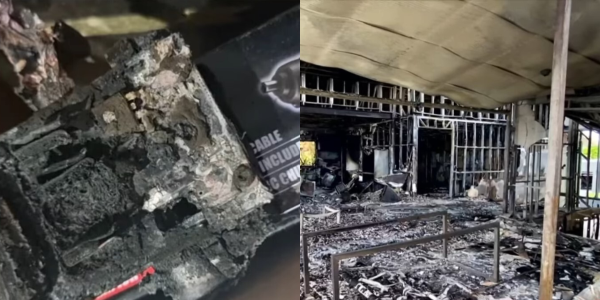Explosion from common battery-powered house tool costs homeowner $100,000
- Replies 4
The convenience of cordless power tools has revolutionised do-it-yourself projects and home repairs.
However, with every technological advancement comes a set of risks.
A Melbourne family learned this the hard way when their home suffered extensive damage due to an unexpected explosion caused by a seemingly harmless lithium-ion battery from a common house tool.
Kaitlin Speary's day turned into a nightmare when she returned to her Narre Warren residence, only to be greeted by smoke pouring out of the bedroom.
The ensuing fire, which she and the firefighters managed to extinguish, resulted in a staggering $100,000 worth of damage to her family's home.
The source of the blaze? An Ozito lithium-ion battery, commonly used in cordless drills, which had exploded.

According to Speary, the battery, typically what would be connected to a cordless drill, wasn't charging at the time of the explosion.
'It was just sitting on a table,' she recounted, highlighting the seemingly benign circumstances that led to the disaster.
‘Only the fact that the bedroom door was shut was what stopped the house from being fully engulfed (in flames).’
Lithium-ion batteries are commonly used in modern households, powering everything from power tools to laptops, vacuum cleaners, and e-scooters.
Their widespread use, however, does not come without hazards.
‘The biggest risk is when lithium-ion batteries have been damaged or waterlogged, and that’s where we start seeing fires caused by the damaged battery,’ Darren McQuade from Fire Rescue Victoria explained.
Moreover, using incompatible chargers or leaving batteries on flammable surfaces, such as a couch, could also cause overheating and subsequent fires.
Across Victoria, fire crews are responding to an average of three to four fires each week ignited by lithium-ion batteries.
In response, Ozito asserted that it is 'taking the matter extremely seriously and is investigating the cause of the incident’.
As news incidents like this surface, concerns over the safety of common components in electronic gadgets are reignited.
The alarming incident underscored the potential risks associated with lithium-ion batteries, prompting renewed warnings about their usage and handling.
This unsettling revelation serves as a stark reminder for consumers to exercise caution when using electronic devices powered by such batteries, and emphasises the importance of being informed and vigilant about potential safety hazards posed by everyday household items and electronic devices.

Have you had any experiences with battery safety or mishaps in your home? What are your tips to prevent such incidents? Share your stories and tips in the comments below.
However, with every technological advancement comes a set of risks.
A Melbourne family learned this the hard way when their home suffered extensive damage due to an unexpected explosion caused by a seemingly harmless lithium-ion battery from a common house tool.
Kaitlin Speary's day turned into a nightmare when she returned to her Narre Warren residence, only to be greeted by smoke pouring out of the bedroom.
The ensuing fire, which she and the firefighters managed to extinguish, resulted in a staggering $100,000 worth of damage to her family's home.
The source of the blaze? An Ozito lithium-ion battery, commonly used in cordless drills, which had exploded.

A fire caused more than $100,000 worth of damage after a lithium-ion battery from an Ozito cordless drill exploded. Credits: Facebook / 7NEWS Melbourne
According to Speary, the battery, typically what would be connected to a cordless drill, wasn't charging at the time of the explosion.
'It was just sitting on a table,' she recounted, highlighting the seemingly benign circumstances that led to the disaster.
‘Only the fact that the bedroom door was shut was what stopped the house from being fully engulfed (in flames).’
Lithium-ion batteries are commonly used in modern households, powering everything from power tools to laptops, vacuum cleaners, and e-scooters.
Their widespread use, however, does not come without hazards.
‘The biggest risk is when lithium-ion batteries have been damaged or waterlogged, and that’s where we start seeing fires caused by the damaged battery,’ Darren McQuade from Fire Rescue Victoria explained.
Moreover, using incompatible chargers or leaving batteries on flammable surfaces, such as a couch, could also cause overheating and subsequent fires.
Across Victoria, fire crews are responding to an average of three to four fires each week ignited by lithium-ion batteries.
In response, Ozito asserted that it is 'taking the matter extremely seriously and is investigating the cause of the incident’.
As news incidents like this surface, concerns over the safety of common components in electronic gadgets are reignited.
The alarming incident underscored the potential risks associated with lithium-ion batteries, prompting renewed warnings about their usage and handling.
This unsettling revelation serves as a stark reminder for consumers to exercise caution when using electronic devices powered by such batteries, and emphasises the importance of being informed and vigilant about potential safety hazards posed by everyday household items and electronic devices.
Key Takeaways
- A Melbourne home was significantly damaged by fire, with the cause believed to be an exploding lithium-ion battery from a power tool.
- The battery, which was from an Ozito cordless drill, was not charging at the time it exploded and caused around $100,000 worth of damage.
- Fire Rescue Victoria highlighted the risks of fires caused by damaged or waterlogged lithium-ion batteries and warned against using non-specific chargers.
- Ozito is investigating the cause of the incident and is taking the matter extremely seriously.
Last edited:







